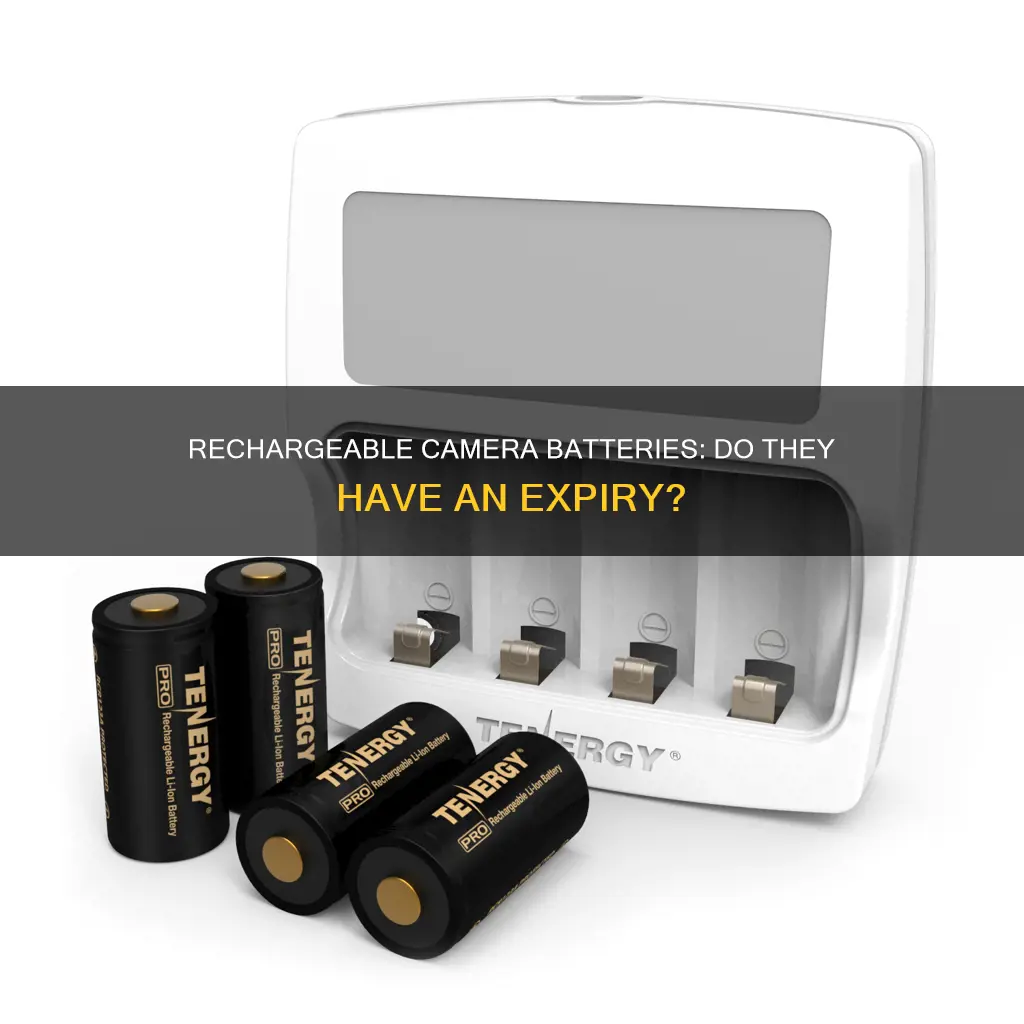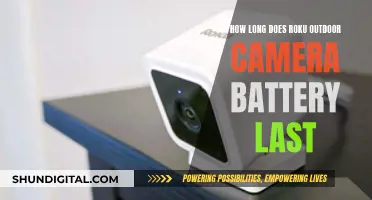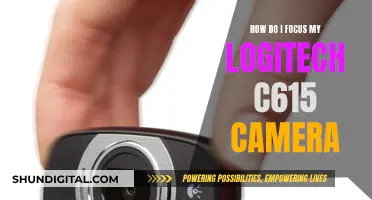
Rechargeable batteries are a great way to save money and reduce waste, but do they wear out? The short answer is yes, all rechargeable batteries will eventually wear out. Every time a rechargeable battery is used, it loses a small amount of capacity, and over time this can lead to a significant decrease in performance. The good news is that there are ways to prolong the life of your rechargeable batteries and maximise their lifespan.
| Characteristics | Values |
|---|---|
| Do rechargeable camera batteries wear out? | Yes |
| How long do rechargeable camera batteries last? | It is difficult to provide an exact life expectancy. It depends on usage, environment, and type of product. |
| How often should rechargeable batteries be replaced? | When they no longer meet your requirements. |
| How to prolong the life of rechargeable batteries? | Do not expose to water or extreme heat; store in a cool, dry place when not in use for long periods; charge and use at least once a year. |
| Best rechargeable batteries for cameras? | NiMH (Nickel Metal Hydride) or Li-ion (Lithium-ion) batteries are recommended. |
What You'll Learn

How to prolong the life of rechargeable batteries
Rechargeable batteries, like all batteries, will eventually wear out. However, there are several things you can do to prolong their life. Here are some tips:
Avoid Extreme Temperatures
Do not expose your batteries to extreme temperatures, especially heat. Do not leave them in hot places such as a car or under direct sunlight. If you need to store your batteries for a long time, keep them in a cool, dry place.
Charge at Room Temperature
Never charge a cold battery. If you try to charge a battery below 0°C (32°F), you can cause crystals to grow inside, which will destroy it. Always let your batteries warm up to room temperature before charging or using them.
Avoid Overcharging
Avoid charging your batteries to 100%. It is the final charge above 90% that cuts the life of your battery. So, if your device is charging and reaches 90%, don't wait for that last bit of charge before taking it off the charger.
Avoid Deep Discharging
Frequently adding small amounts of charge is recommended. Don't let your battery drain completely before recharging it. A fully depleted battery has a shorter life.
Store in the Fridge
Putting batteries in the fridge can help prolong their life, especially if you live in a hot climate. This works great for NiMH batteries, which will retain 90% of a full charge while stored in the fridge. Just remember to let them warm up to room temperature before use.
Use the Right Battery
Make sure you are using the right type of battery for your device. Not all batteries are created equal, and some may not be suitable for high-drain applications.
Remove from Seldom-Used Devices
If you have devices that you only use occasionally, remove the batteries and store them in a cool, dry place. This will help prolong their life.
Why 18650 Batteries Are Popular in Cameras
You may want to see also

How to store rechargeable batteries
Rechargeable batteries are perishable and deteriorate over time. Here are some tips on how to store them to maximise their lifespan:
Storing Batteries
- Keep batteries in their original packaging if possible, as this protects them from environmental factors such as humidity.
- If you don't have the original packaging, store batteries in a plastic container.
- Separate batteries by make and age. Keep them in separate containers or, if using one container, place each type in its own plastic bag.
- Store batteries at room temperature or below, in a cool, dry place away from direct sunlight. The optimum temperature range for storing batteries is between −20° C and +45° C (−4° F to 113° F).
- Do not store batteries in the freezer.
- Control humidity. Keep batteries in a vapor-proof container if they are in a high-humidity environment or if there is a risk of condensation.
- Prevent electrical conduction by not storing batteries in a metal container. Use a sealed plastic container or a specialised battery storage box instead.
- Do not store coins or other metal objects in the same container as your batteries.
- Align batteries so that the positive terminals cannot come into contact with the negative terminals of other batteries. Cover the terminals with masking tape or plastic caps if necessary.
Maintaining Rechargeable Batteries
- Check the charge levels of rechargeable batteries. Lead acid and lithium-ion batteries should be stored at full charge, while lithium-ion batteries should be stored at 30-50% maximum charge. Nickel-based batteries can be stored at any state of charge.
- Recharge lead acid and lithium-ion batteries periodically.
- Restore discharged batteries. If rechargeable batteries drop to low charge levels for several days, they may require special treatment before you can use them again.
Charging Your Camp Snap Camera: A Quick Guide
You may want to see also

How to know when rechargeable batteries are worn out
Rechargeable batteries do wear out over time, and there are several ways to tell if they are coming to the end of their life. Firstly, if you have been using your device for years without any problems, but suddenly it is only lasting a fraction of the time before it needs recharging, this is a tell-tale sign that your battery is worn out. For example, if you used to get 6 hours of battery life, and now you can only get 90 minutes, it's probably time for a new battery.
Secondly, if your battery is taking much longer to charge than it used to, this could be a sign that it is worn out. Rechargeable batteries are usually good for 500-1000 recharge cycles before they start to degrade noticeably. Once you have hit this number of cycles, you can assume the battery is at the end of its life.
Thirdly, if your battery is draining quickly after only a few charges, this could be a sign that the battery terminals and charger connectors are dirty. In this case, cleaning them with a microfiber cloth and isopropyl rubbing alcohol may help.
Other signs that your rechargeable battery is worn out include physical damage to the battery, such as a bulge or bump in the case, cracks or ruptures in the plastic, or broken or loose terminals. If you see any of these signs, it's probably time to replace your battery.
Baby Camera Cloud Storage: Charging for Your Dog's Memories?
You may want to see also

The best rechargeable batteries
All rechargeable batteries will eventually wear out, but there are steps you can take to prolong their life. Rechargeable batteries are more expensive than single-use batteries, but they can save you money in the long run.
When it comes to rechargeable batteries for cameras, AA and AAA batteries are the most popular sizes. Most rechargeable AA and AAA batteries use nickel-metal hydride (NiMH) technology because of its large capacity. Low self-discharge (LSD) batteries are the best because they hold their charge for longer when your device is not in use.
Best Overall: Panasonic Eneloop 2100 Cycle Ni-MH Rechargeable Batteries
These batteries are ideal for devices that drain your batteries daily. They can be recharged up to 2,100 times and have a 2,000mAh capacity, with the AAAs offering 800mAh. They can maintain 70% of their charge when left in storage for 10 years and have been known to hold 82% of their charge capacity after sitting idle on a shelf for nine months.
Best Eco-Friendly: Energizer Rechargeable Batteries
These batteries are not only the first cells to be partially made of recycled batteries, but they also perform well. They come pre-charged, with the AAs offering a 2,000mAh capacity and the AAAs rated at 800mAh. They can last for up to a year in storage without losing their charge.
Best Budget: Tenergy Rechargeable NIMH Batteries
If you don't plan on charging your batteries more than 500 times, these batteries perform just as well as the major brands but at a lower cost. The AA Tenergy batteries are rated at a 2,000mAh capacity, and the AAAs have an 800mAh rating. According to buyers, the batteries tend to be closer to 2,100mAh and 900mAh, respectively.
Best for Speedlights: Duracell Rechargeable 2500 mAh
These batteries delivered 228 pops of a flash on full power with very fast recycle times. They are also a good choice for high-drain devices, as they provide steady power output until they are depleted.
Best Value: Standard Eneloop (2000 mAh) Rechargeable Battery
The Standard Eneloop offers fast recycle times, with the first shot recycle time at 6.5 seconds and the 75th shot recycle time at 11.3 seconds. The total time to fire 75 full power shots was 723 seconds.
To prolong the life of your rechargeable batteries, avoid exposing them to water or extreme heat, and store them in a cool, dry place when not in use. It is also recommended to charge and use the batteries at least once a year to maintain proper function.
Are Batteries Included? Camera Shopping Basics
You may want to see also

The best rechargeable battery chargers
Yes, rechargeable batteries do wear out over time. Every time a rechargeable battery is used, it loses a small amount of capacity, and this can become a problem if you don't have any spare capacity to lose.
Now, here are some of the best rechargeable battery chargers to help you get the most out of your batteries:
Panasonic Eneloop BQ-CC55
The Panasonic Eneloop BQ-CC55 is a simple and intuitive charger. It features a fold-out plug that sits flush on your wall outlet and notification lights that indicate when each battery is dead, half-full, or fully charged. It can charge up to four AA or AAA NiMH batteries at a time and has an auto-shutoff function to prevent overcharging. The compact design and neutral, unobtrusive look make it a great choice for most households.
Tenergy TN480U
The Tenergy TN480U is ideal for those who regularly need to charge multiple batteries at once. It has eight individually charging battery slots for AA, AAA, and AAAA batteries. The TN480U's screen provides detailed information on the charging status of each battery, and its compact design makes it easy to blend into any surroundings. This charger is powered via Micro-USB or USB-C and comes with a Micro-USB charging cable.
Tenergy TN456
The Tenergy TN456 is perfect for those who want more control over their battery charging. It allows you to set custom charge rates and measures battery capacity, voltage, internal resistance, and charge times. This charger is compatible with both lithium-ion and nickel-based batteries and can handle AA, AAA, AAAA, and C battery sizes. It also includes a USB-A output port for added convenience.
SKYRC MC3000
The SKYRC MC3000 is a top-of-the-line, advanced battery charger that can handle various battery chemistries, including NiMH, Lithium-Ion, LiFePO4, and more. It offers full manual control over charging parameters and can be connected to your smartphone via Bluetooth for easy setting adjustments. While it may be too complex for non-tech-savvy users, it is an excellent choice for those who want the utmost control and flexibility in charging their batteries.
Opus BT C3100
The Opus BT C3100 is a great budget option for those seeking a multi-chemistry charger. It can charge lithium-ion batteries of various sizes, as well as AA and AAA rechargeable batteries. The charger includes a refresh mode to help bring NiMH batteries closer to their full capacity. It also has a display that shows the charging status for each bay separately. This charger offers a lot of features at a very reasonable price.
Charging the Kidizoom Duo Camera: A Step-by-Step Guide
You may want to see also
Frequently asked questions
Yes, all rechargeable batteries wear out. Every time a rechargeable battery is used, it loses a small amount of capacity.
It depends on your run time requirements.
When they no longer meet your requirements, i.e. if the decreased usage time between charges becomes significant, it is probably time to replace the battery with a new one.
It is difficult to provide an exact life expectancy as it depends on several factors such as the amount of use, the environment in which the battery is being used, and the type of product with which the battery is being used.
Follow these guidelines:
- Do not expose the battery pack to water.
- Do not leave the battery pack in extremely hot places, such as in a car or under direct sunlight.
- Store the battery in a cool, dry place if it is not going to be used for a long time.
- Charge the battery and use it at least once a year to maintain proper function.







